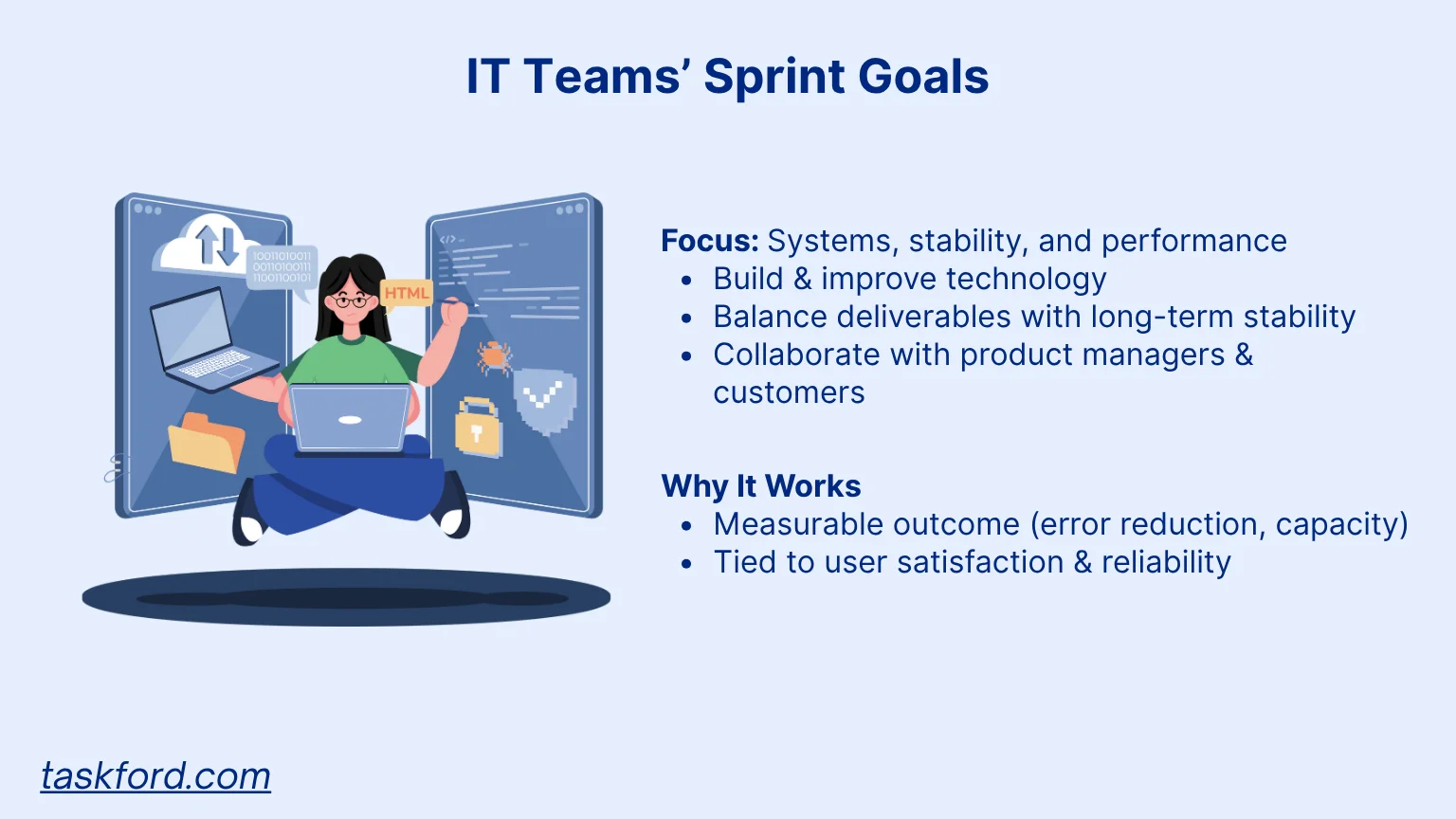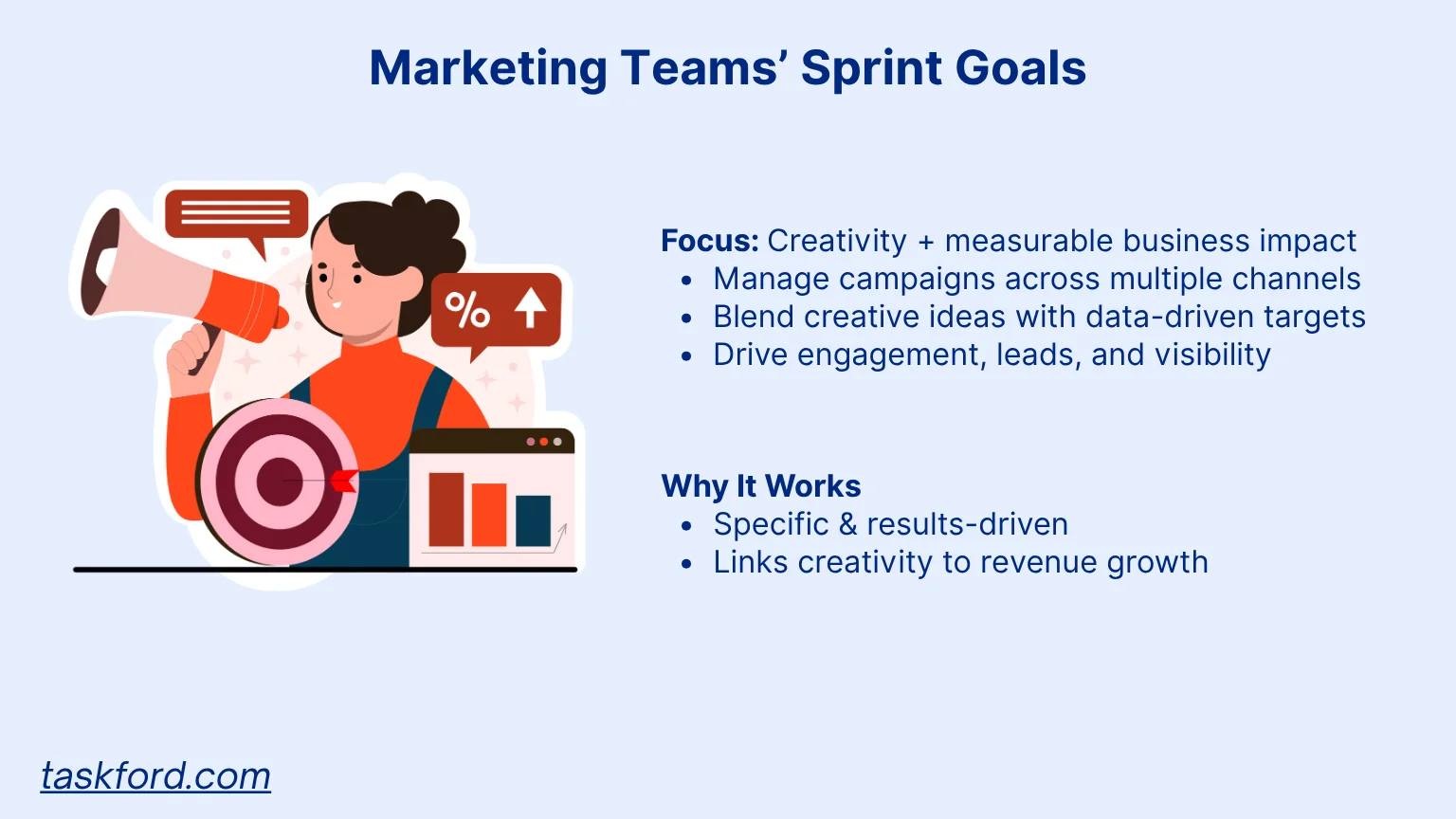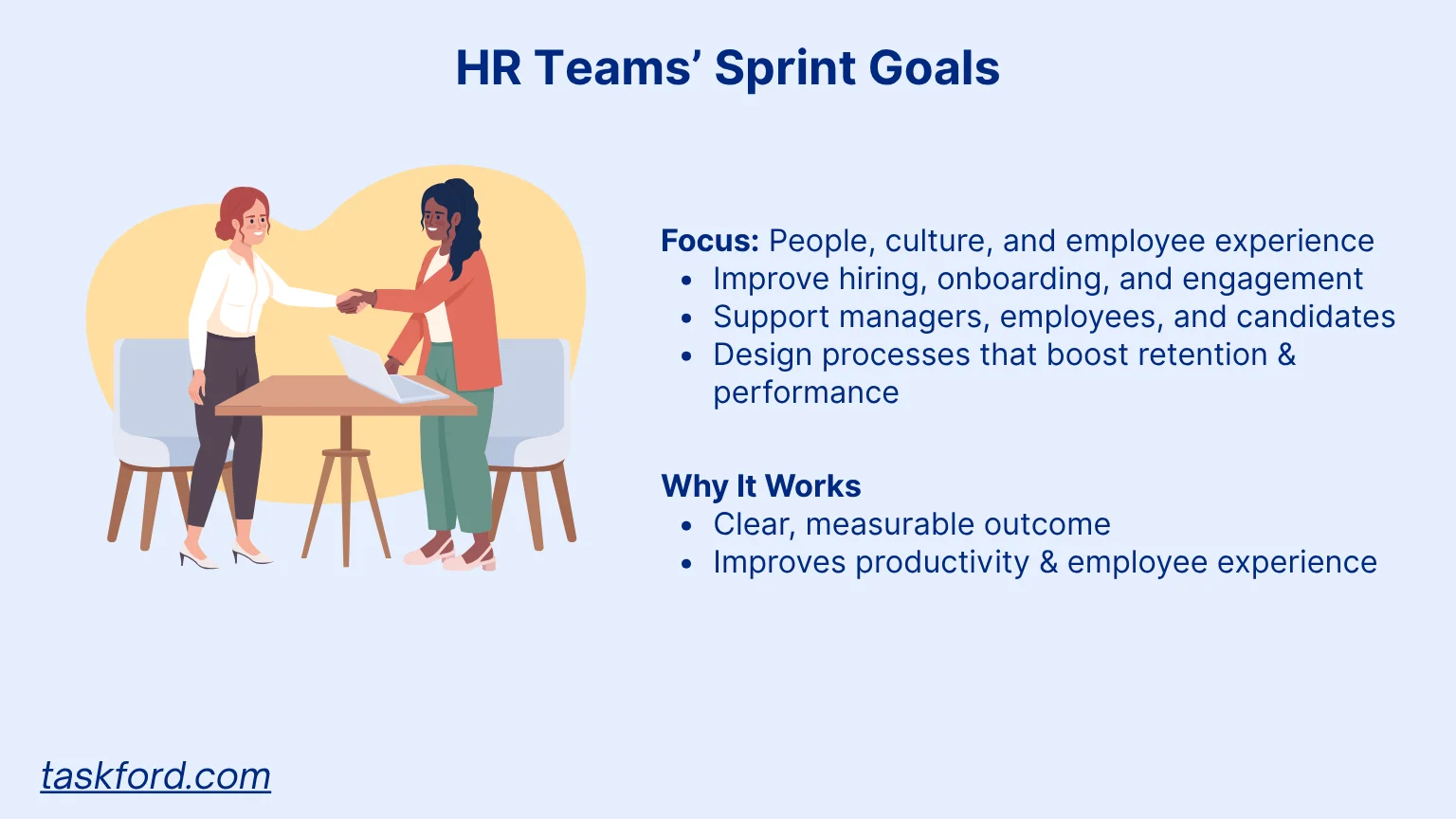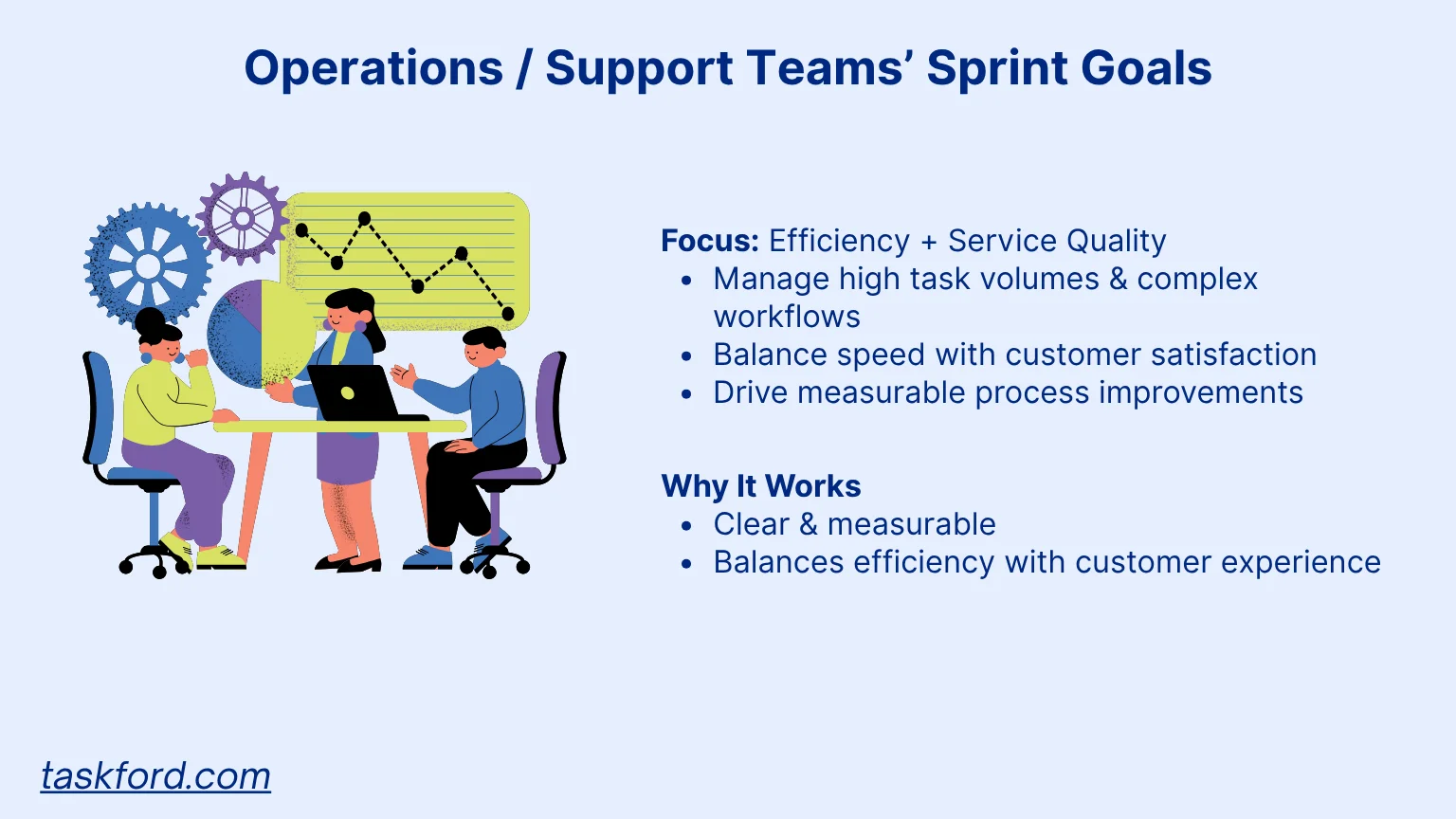Not All Sprint Goals Are Created Equal: How Teams Shape Goals to Fit Their Work
Discover how different teams craft unique sprint goals to drive Agile success in this insightful guide to effective sprint planning and project management.
Agile has spread beyond coding. Sprint goals, once a tech-only tool, now drive progress in marketing, HR, IT, and operations. But here’s the twist: every team’s sprint goals look different. Why? Their work, metrics, and impact vary. In this blog, we’ll define what a sprint goal is, explore how teams craft theirs, dive deep into what makes a goal great, highlight common pitfalls, and share actionable tips for better goals and sprint planning, all while keeping things clear, engaging, and focused on results.
What Is a Sprint Goal?
A sprint goal is a concise, outcome-driven statement that defines what a team aims to achieve in a sprint, typically a one- to four-week period. It’s not a task list or a vague idea. It’s a focused objective that guides the team and ties to bigger business goals. Born in Scrum, sprint goals emphasize impact (like “boost traffic by 10%”) over tasks (like “publish three posts”). They’re clear, measurable, and flexible, helping any team, tech or not, deliver value fast and enhance their sprint planning.
Why Sprint Goals Vary Across Teams
Teams craft goals based on their unique context. Three factors drive the differences:
- Nature of Work: Engineers build features. Marketers launch campaigns. HR improves employee experience. Operations streamlines processes. Each team’s output shapes its goals.
- Success Metrics: Engineers track adoption or bugs. Marketers measure leads or clicks. HR focuses on retention. Operations cares about resolution times. Goals reflect these metrics.
- Stakeholders: Engineers serve customers. Marketers target audiences. HR supports employees. Operations balances clients and teams. Goals speak to these groups.
This means goals must fit the team’s role while staying true to Agile project management’s focus on value.
What Sprint Goals Look Like Across Teams
Let’s explore how different teams craft sprint goals, with examples that show their unique approach.
Engineering/IT Teams

Engineering and IT teams build and improve systems, so their goals are technical, precise, and tied to user experience or performance. They often juggle immediate deliverables with long-term system stability, collaborating with product managers or customers.
Example: “Release a mobile login feature that cuts errors by 40% and supports 10,000 users.”
This goal targets a specific feature (mobile login) with clear metrics (error reduction, user capacity). It aligns with user satisfaction and scalability, giving the team flexibility to code or test as needed. It also supports business priorities like user retention and system reliability.
Why It Works: It focuses on impact (fewer errors, better scalability) rather than tasks, ensuring the team delivers measurable value.
Marketing Teams

Marketing blends creativity and data, crafting goals around campaigns or brand impact with measurable outcomes like leads or engagement. They manage multiple channels (social, email, web) and tight deadlines, so goals must be focused yet flexible.
Example: “Launch Product X’s social media campaign, generating 500 qualified leads with a 5% click-through rate.”
This goal is specific (Product X campaign) and results-driven (leads, click-through rate). It allows the team to experiment with platforms or messaging while focusing on growth. It ties directly to marketing’s role in driving revenue and brand visibility.
Why It Works: It balances creative freedom with clear business outcomes, ensuring the campaign delivers measurable impact.
HR/People Teams

HR focuses on people, from hiring to culture, so their goals emphasize employee experience or process improvements. They work with diverse stakeholders (employees, managers, candidates), so goals must be clear and relevant to all.
Example: “Pilot a new sales onboarding program with 80% satisfaction in feedback surveys.”
This targets a specific group (sales) and outcome (satisfaction), with a pilot phase to test impact. It supports HR’s mission to boost performance and retention, leaving room for creative program design.
Why It Works: It’s measurable, employee-focused, and aligns with organizational goals like productivity.
Operations/Support Teams

Operations and support aim for efficiency and service quality, targeting measurable improvements in speed or satisfaction. They handle high task volumes or complex workflows, so goals need precision and impact.
Example: “Cut ticket resolution time from 48 to 36 hours with 90% customer satisfaction.”
This goal prioritizes efficiency (faster resolution) and quality (satisfaction), aligning with customer-centric goals. The team can optimize workflows or tools to hit the target, balancing speed with service quality.
Why It Works: It’s clear, measurable, and reflects operations’ role in driving efficiency and satisfaction.
Each team’s goals reflect their work and stakeholders, but all aim to deliver value in a sprint.
Comparison Table
| Team | Focus Area | Primary Metric | Challenges |
|---|---|---|---|
| Engineering/IT | Building and improving systems | Error reduction, user adoption | Balancing new features with system stability, managing technical debt |
| Marketing | Campaigns and brand impact | Leads, click-through rate | Balancing creativity with measurable outcomes, managing tight deadlines |
| HR/People | Employee experience, processes | Satisfaction, retention | Measuring qualitative outcomes, addressing diverse needs |
| Operations/Support | Efficiency and service quality | Resolution time, satisfaction | Handling high task volumes, balancing speed with quality |
The Hallmarks of a Great Sprint Goal
Great sprint goals share traits that make them powerful for project management. Here’s what sets them apart:
- Clear as Day: A great goal is instantly understandable, avoiding jargon. “Cut page load time by 20%” is precise, while “improve system” confuses stakeholders. Clarity ensures team collaboration, especially when marketing and engineering work together. It helps non-technical leaders see the value, fostering trust and keeping everyone aligned during sprint planning.
- Big-Picture Aligned: Goals must connect to business priorities like revenue or retention. An HR goal to improve onboarding supports productivity, a company-wide need. This alignment secures resources and stakeholder buy-in. In sprint planning, teams should map goals to strategic objectives to ensure they drive meaningful outcomes for the organization.
- Sprint-Sized: Goals need to fit a sprint’s one- to four-week timeframe. “Rebuild the platform” is too big, risking burnout. “Optimize one checkout feature for 5% more conversions” is achievable. This balance keeps teams motivated and ensures steady progress. Effective planning involves assessing team capacity to scope goals realistically.
- Outcome-Focused: Goals prioritize results over tasks. “Increase stakeholder confidence with a new reporting process” beats “write three reports.” This mindset drives value, like how faster support boosts loyalty. In Agile methodology, outcome-driven goals push teams to solve real problems, ensuring project management delivers measurable impact.
These traits make sprint goals clear, aligned, and impactful.
Where Teams Trip Up
Even skilled teams stumble in sprint planning. Here’s how to avoid common goal-setting pitfalls:
- Checklist Trap: Goals like “send five emails” focus on tasks, not impact, undermining Agile methodology. Task-based goals limit creativity and skip measuring success. Instead, “boost social media reach by 10%” drives strategic thinking. In sprint planning, prioritize outcomes over activities to ensure goals deliver value and align with project management principles.
- Too Vague: Broad goals like “improve processes” lack focus, causing confusion. Without specifics, teams waste effort or drift off track. “Cut ticket resolution time by 12 hours” provides direction. To avoid vagueness, include measurable metrics in goal setting. This keeps teams focused and ensures sprint velocity, leading to actionable outcomes.
- No Business Link: Goals disconnected from priorities lose relevance. Redesigning a high-performing website wastes resources when growth is the focus. “Optimize the checkout page for 5% more conversions” ties to revenue. In Agile, align goals with strategic objectives to maintain stakeholder alignment and ensure the team’s work matters to the organization.
- Copycat Goals: Using another team’s goal style ignores your team’s needs. HR mimicking engineering’s technical goals can’t capture people-focused outcomes. “Streamline hiring” should reflect candidate experience, not system updates. In goal setting, tailor goals to your team’s metrics and work style to ensure they’re relevant and achievable in the Scrum framework.
Avoiding these traps keeps goals focused and effective.
Tips for Better Sprint Goals
Crafting great sprint goals takes skill. Here are strategies to get it right:
- Speak Value: Use metrics that matter to your function. Marketing should focus on leads, like “generate 500 leads.” HR should target satisfaction, like “achieve 80% onboarding satisfaction.” Operations should emphasize efficiency, like “cut resolution time by 12 hours.” Clear metrics, tracked in tools like TaskFord or Microsoft Excel show stakeholders the goal’s worth. In goal setting, identify the key metric that defines success to drive measurable impact.
- Team Ownership: Involve stakeholders for context, but let the team shape the goal. Marketing might consult sales for revenue needs, but marketers should craft the goal. Ownership boosts motivation and ensures realistic goals. In sprint planning, facilitate collaborative sessions to balance stakeholder input with team expertise, fostering commitment and effective project management.
- Review Impact: Use sprint reviews to assess if goals delivered. Did the campaign meet its lead target? Did onboarding improve satisfaction? Data reveals what worked. Operations might find faster ticket times hurt quality, prompting tweaks. In the Scrum framework, reviews create a feedback loop, refining goals to be sharper and more effective over time.
These strategies ensure goals are clear, owned, and results-driven.
The Takeaway: Agile Is for Everyone
Agile methodology isn’t just for tech teams. Marketing, HR, IT, operations, every function can use sprint goals to drive progress. With tools like TaskFord, teams can streamline sprint planning and align goals effectively. The key is crafting goals that fit the team’s work while keeping them clear, aligned, and outcome-driven. Whether you’re coding a feature, launching a campaign, streamlining support, or boosting satisfaction, great sprint goals follow the same principles. Master goal setting in sprint planning, and you’ll unlock Agile’s power for project management across your organization.
Learn more
- How Long Is a Sprint in Agile? 1-Week vs 2-Week vs 4-Week Sprints
- Scrum vs Sprint: Why the Debate Exists and What Teams Really Need to Understand
- What is Project Management? The Complete First Guide for Newbies
Subscribe for Expert Tips
Unlock expert insights and stay ahead with TaskFord. Sign up now to receive valuable tips, strategies, and updates directly in your inbox.